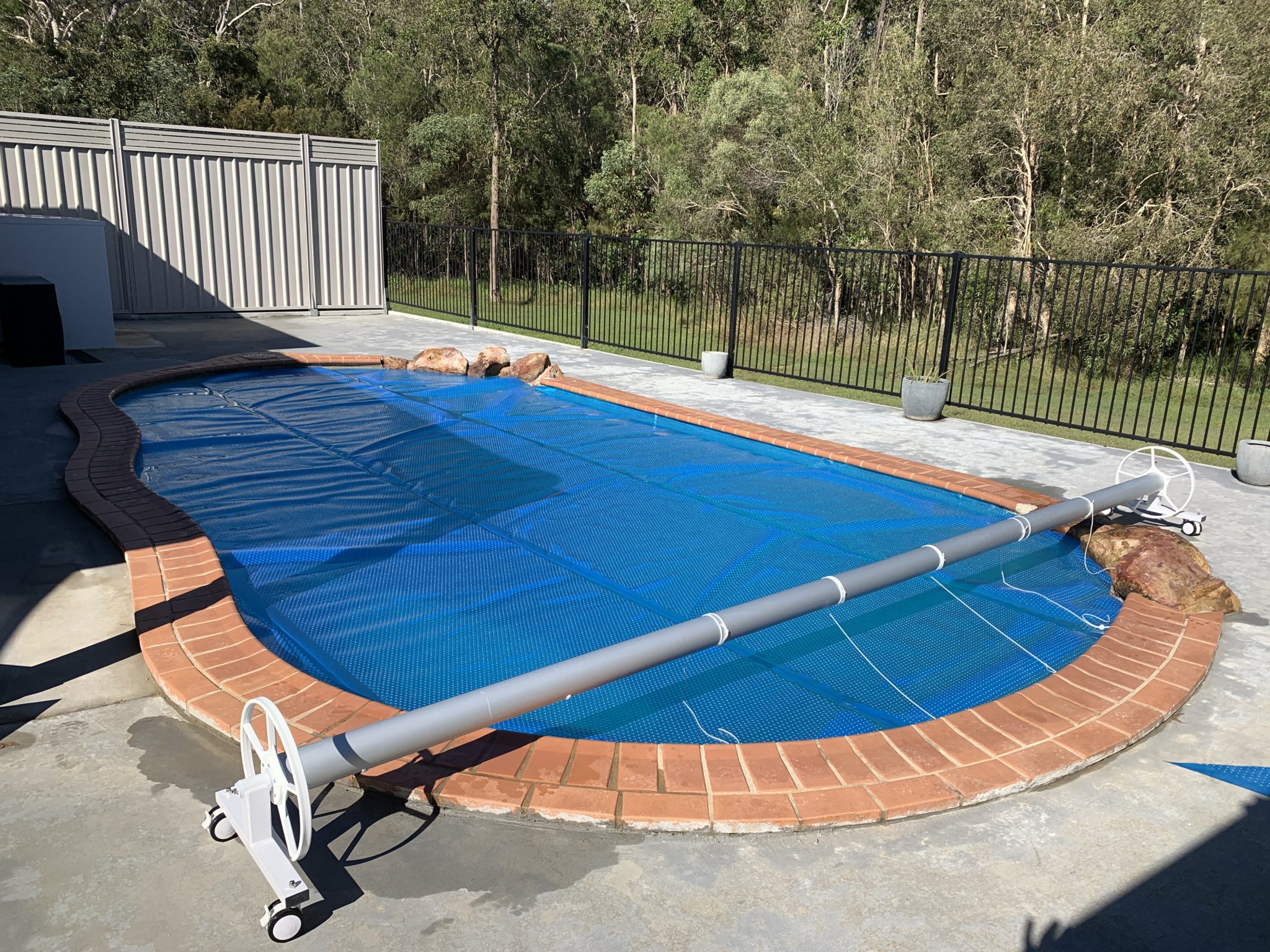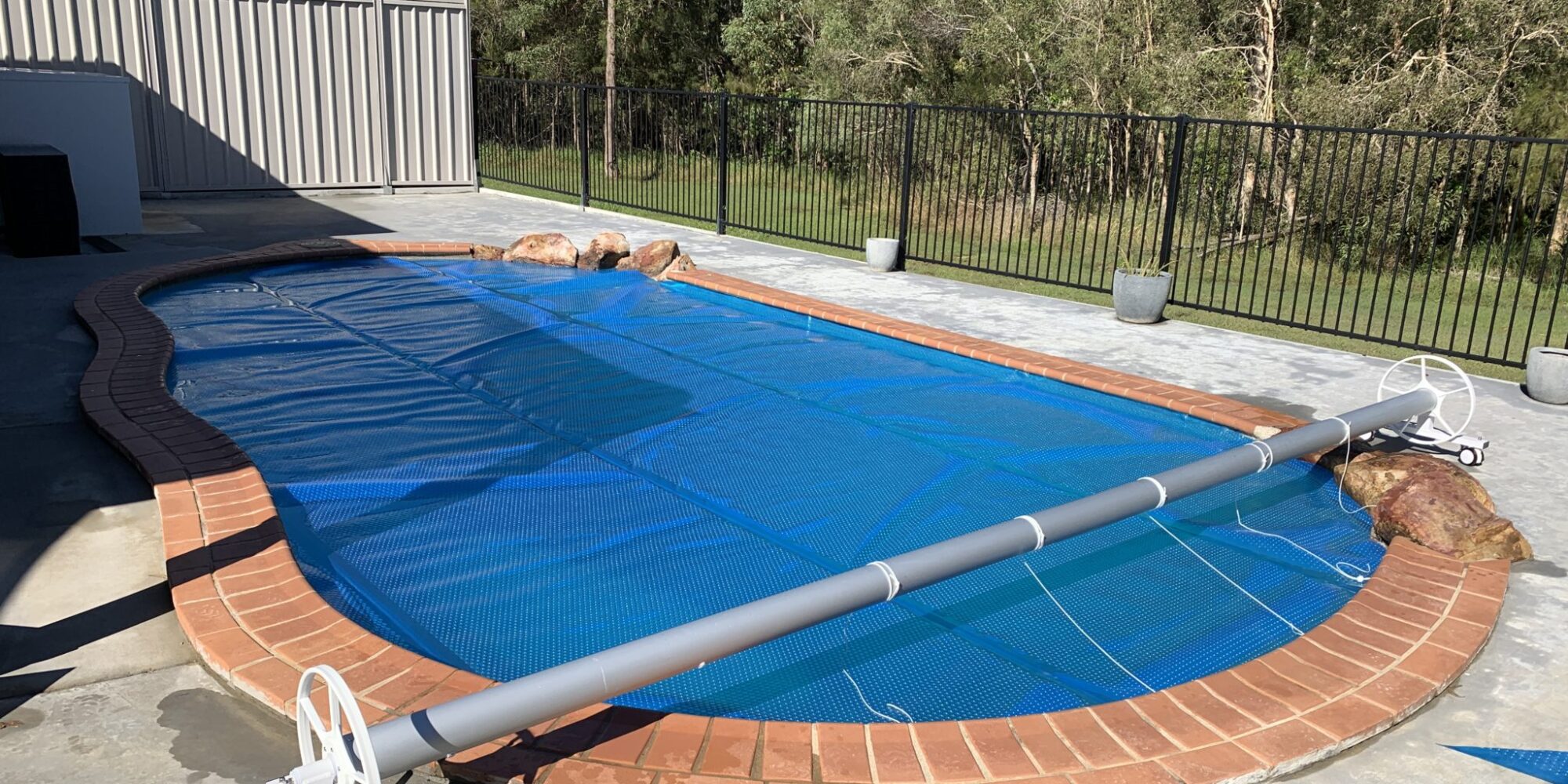
16 Feb Do I need a Roller for My Pool Cover?

Today we’re covering all your frequently asked questions about pool rollers, diving into the ocean of possibilities they bring to your outdoor oasis. From understanding what pool rollers are to exploring their types, benefits, and drawbacks, we’ll cover it all.
Pool Roller FAQs for Your Home’s Pool Cover
What is a Pool Roller?
A pool roller is a device designed to facilitate the easy handling and storage of pool covers. Its primary purpose is to make covering and uncovering your pool a seamless process, enhancing the overall effectiveness of the cover in maintaining water quality and temperature.
Proper handling of pool covers is crucial for their longevity and performance, and a pool roller helps in smooth unrolling and rolling up of the cover. This reduces the chances of wear and tear that may occur when manually pulling or folding the cover.
A typical pool roller consists of a sturdy frame, a crank or motorised mechanism for rolling the cover, and wheels for easy mobility.
What are the Types of Rollers?
Manual Pool Rollers
Cost-effective and straightforward, these usually come with a hand-crank mechanism that allows you to roll and unroll the cover with minimal effort. Manual rollers are a suitable option for those who prefer a hands-on approach to cover management.
While manual rollers are budget-friendly, they require physical effort to operate. Consider your preference for convenience and the size of your pool when deciding if a manual roller is the right choice for you.
Automatic Pool Rollers
These offer unparalleled convenience. With the push of a button, the cover smoothly glides on or off the pool. This type of roller is ideal for those who prioritise ease of use and want to automate the cover handling process.
While automatic rollers provide convenience, they are typically more expensive than their manual counterparts. Consider your budget and the long-term benefits of automation when deciding if an automatic pool roller is the right investment for you.
Do Rollers Extend the Life of the Cover?
Yes – investing in a pool roller can significantly contribute to extending the life of your pool cover.
- Motion: The smooth, controlled motion provided by rollers minimises the stress and friction that manual handling might cause. This reduction in wear and tear ensures that your pool cover stays in good condition for an extended period.
- Protection & Storage: Pool covers are exposed to the elements and can face damage from UV rays, debris, and harsh weather conditions. By using a roller, you reduce the likelihood of damage while it’s stored.
Where Should I Put the Roller?
Determining the right location for your pool roller is essential for its functionality and aesthetics. Ideally, place the roller in a position that allows easy access to the pool. This could be near the edge of the pool deck or in a designated storage area.
Consider the available space around your pool. Ensure there’s enough room for the cover to be comfortably rolled and unrolled without any obstructions.
A well-designed pool roller can also enhance the overall look of your pool area. In the early stages of your pool roller journey, choose a roller that complements the style of your pool and surrounding landscape, creating a harmonious visual appeal.
Should I Leave My Pool Cover on During the Day?
Leaving your pool cover on during the day has several advantages, most significantly the ability to retain heat accumulated in the pool water, especially during cooler seasons. This can result in energy savings as your pool heater won’t need to work as hard to maintain a comfortable temperature.
While keeping the cover on during the day has its benefits, there are situations where it might not be advisable. For example, in extremely hot climates, prolonged coverage may lead to excessive water temperature, potentially creating an uncomfortable swimming environment.
Should Pool Covers Be Tight or Loose?
Maintaining the right tension in your pool cover is crucial for its effectiveness. A cover that is too tight can cause stress on the material, while a loose cover might not provide adequate insulation and protection. A properly tensioned pool cover contributes to better heat retention, preventing heat loss during colder nights. Additionally, it enhances safety by reducing the risk of accidental slips or falls on the cover surface.
Several factors, such as the type of cover material, weather conditions, and the design of your pool, can influence the ideal tension. Consider these to determine the optimal tightness for your pool cover, ensuring it can fulfil its purpose efficiently. You can always speak to an expert like Eco Solar Pool Heating who are experienced pool roller installers to assess the right tension for your specific cover.
Can I Walk on a Pool Cover?
Some pool covers are designed to support the weight of an average person, allowing for safe walking. These are typically reinforced safety covers or solid covers specifically designed for this purpose. Avoid sharp objects or pointed shoes that could damage the cover, and always distribute your weight evenly. Regular inspections of the cover’s integrity are crucial to identify any signs of wear or damage.
However, it’s essential to check the manufacturer’s guidelines to ensure the cover’s suitability for walking. Walking on a pool cover not designed for this purpose can pose risks to yourself, including serious injury, and to the cover, such as tearing or puncturing the material. Additionally, it may compromise the cover’s ability to provide proper insulation and safety.
What are the Negatives of a Pool Cover?
Understanding potential pool cover challenges allows you to proactively address them and make informed decisions. Issues such as debris accumulation, maintenance requirements, and the need for occasional repairs may arise.
Addressing challenges ensures that your pool cover continues to function optimally. Be proactive by:
- Regularly removing debris
- Conducting inspections
- Following maintenance guidelines provided by the manufacturer
- Creating a maintenance schedule to ensure nothing is missed, including:
- Inspections
- Cleaning
- Addressing issues
Can I Use a Pool Cover Without a Roller?
While a pool roller enhances the efficiency of covering and uncovering your pool, it is possible to use a pool cover without a roller. Manual handling involves folding or unfolding the cover by hand. While this method is viable for smaller pools, it may become cumbersome for larger ones.
If you have a small or temporary pool, manual handling without a roller may be a practical choice. Consider the size of your pool, your physical capability, and the frequency of cover use when deciding whether a roller is necessary for your specific situation.
If you opt for manual handling, follow these tips for effective use:
- Enlist the help of others for larger covers.
- Fold or roll the cover systematically to prevent wrinkles.
- Store the cover in a dry, shaded area when not in use to prevent damage.
A roller can enhance the lifespan of your cover, provide convenience, and contribute to the overall aesthetics of your pool area. Remember to weigh the pros and cons, considering your specific needs and circumstances, before choosing yours.
Whether you invest in a manual or automatic roller, proper maintenance and care are essential for maximising the benefits of your pool cover. Make an informed decision, and enjoy the many advantages that a well-maintained pool cover can bring to your swimming experience.
We hope you’ve enjoyed reading through these FAQs. To have a pool roller installed, or talk to experts for professional pool covering and heating advice, contact us at Eco Solar Pool Heating in Brisbane.



No Comments